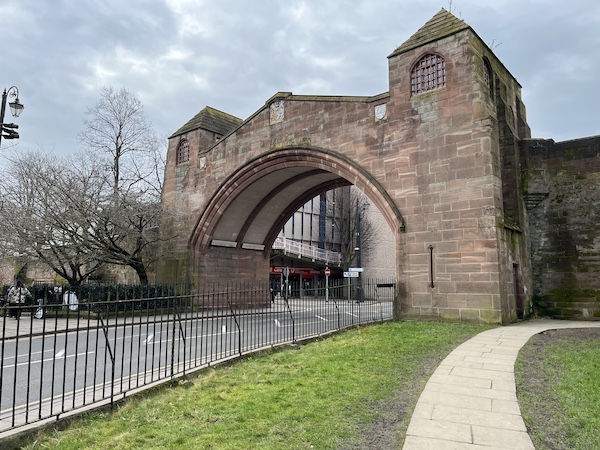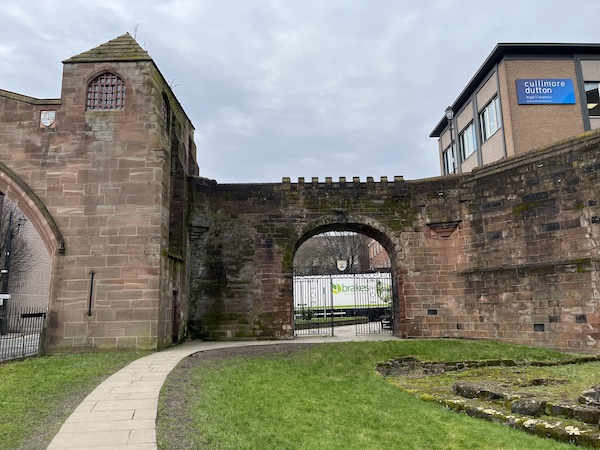Newgate
The Newgate is one of the most recent additions to the city walls and was opened in 1938. As traffic congestion increased in the 1930s, the Wolfgate was deemed too narrow for modern traffic. The architect Sir Walter Tapper was therefore commissioned to design a wider and taller gate, next to the existing Wolfgate. Construction of the Newgate was completed after Walter Tapper’s death, by his son Michael Tapper.

The above view is of the Newgate from outside the City Walls.
The Newgate is of a neo-Gothic style and was designed to blend in with the rest of the medieval walls. It is built of reinforced concrete and faced with red Runcorn sandstone. It features ornamental arrow slits and heraldic shields bearing the arms of the City of Chester. It is also flanked on the west side by the arms of the Prince of Wales and the Grosvenors, and on the east side by those of the Stanleys and the Egertons. The Newgate it is now a protected monument along with the rest of the City Walls.
The earliest recorded gateway at the site of the present day Newgate was Wolfeld’s Gate, in the late 12th century. The original gateway may have dated to before 1066 and the origins of its name are unknown.
The Wolfgate, which was the previous thoroughfare at this section of the walls still stands immediately to the north of the Newgate. The Wolfgate has been known as Pepper Gate in the past and was also referred to as the ‘New Gate” during the reign of Edward VI (1537-1553). In 1573 the Wolfgate was the scene of the romantic elopement of Alderman Rauff Aldersey’s daughter. Her father was unhappy that she had fled the City via the gate to marry a common draper and persuaded the city to lock the gate at night thereafter. The gateway has been rebuilt many times over the centuries. The present Wolfgate archway was rebuilt in 1768.

The above view is of the Wolfgate from outside the City Walls. The Newgate is on the left and the remains of a Roman Angle Tower are on the right.
The Newgate and Wolfgate are at a juncture where the medieval wall was extended south, diverging from the original Roman wall which run from the South-East Angle Tower along what is now Pepper Street and then White Friars. The Roman fortress was of a rectangular ‘playing card' layout with rounded corners. The Romans built towers at each corner of the fortress. The remains of the south-east angle tower can be seen slightly north of the Newgate and Wolfgate. The back wall of the Roman angle tower was used when Chester’s City Walls was rebuilt and extended in the Middle Ages.
If walking around the City Walls, the Newgate is a good place to take a break and take in the sights of the Roman Amphitheatre, the Roman Gardens, the remains of the Roman Angle Tower, and St. John's Church.
